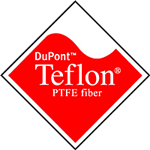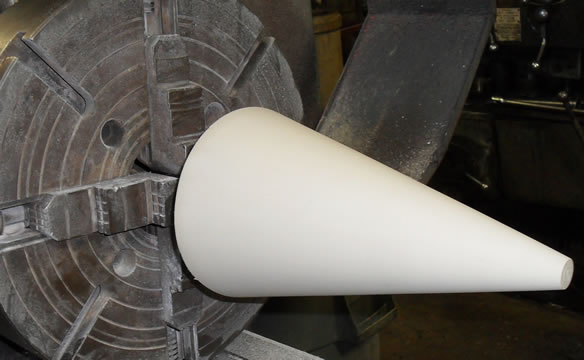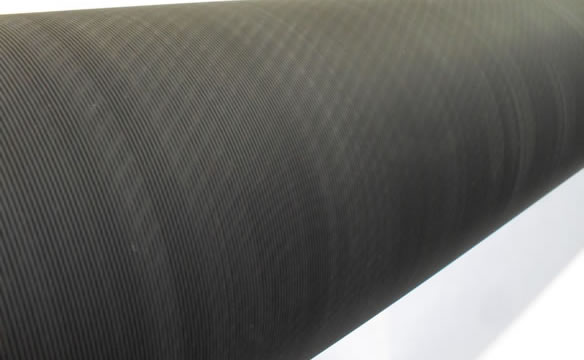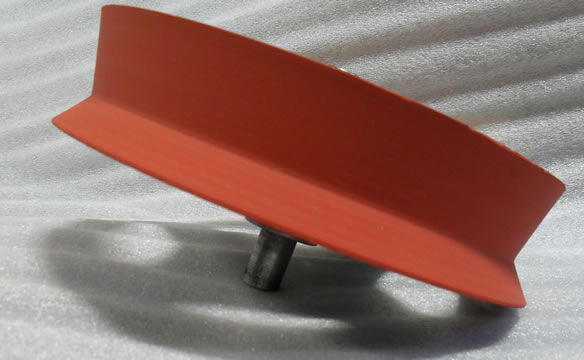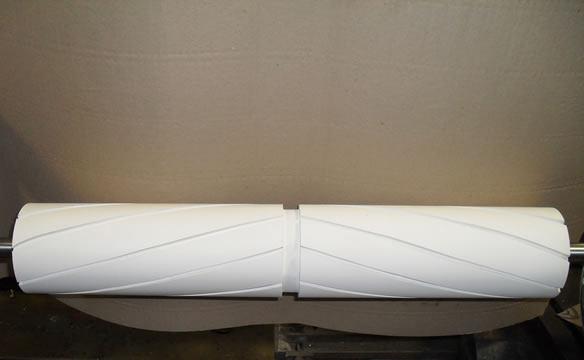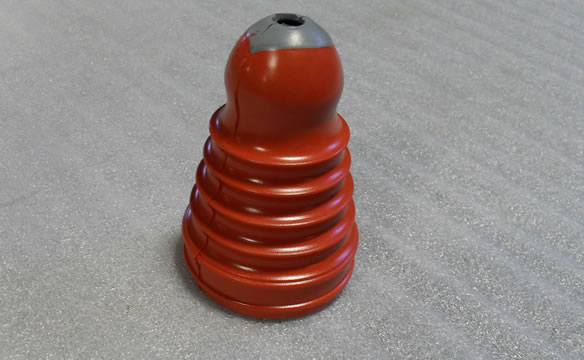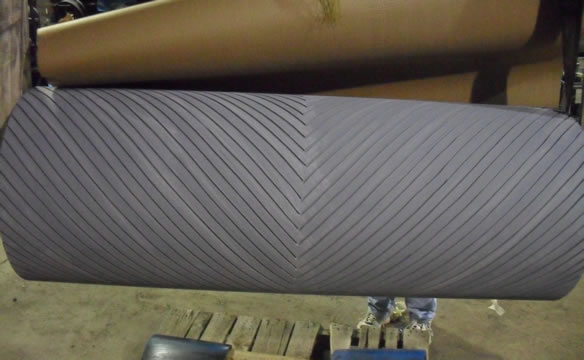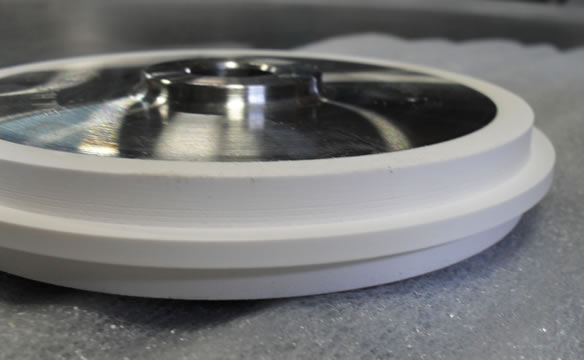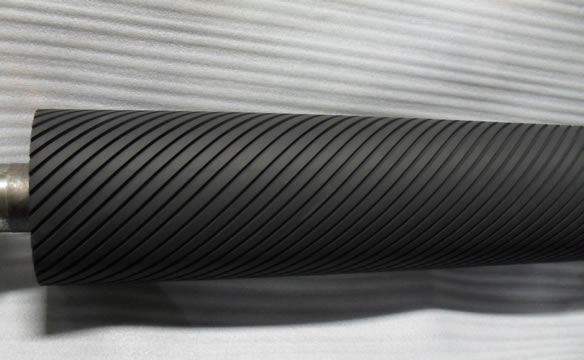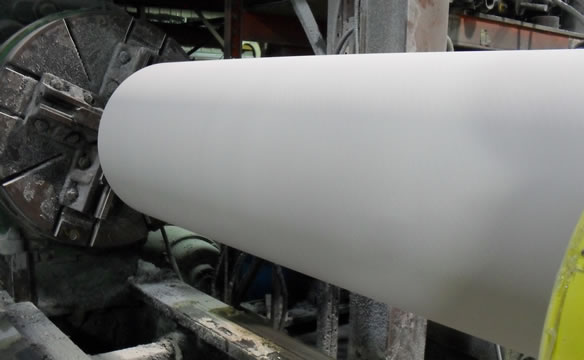Rubber
Neoprene
Neoprene, also referred to as Polychloroprene is a family of synthetic rubbers that are produced by polymerization of chloroprene. Neoprene exhibits good chemical stability, and maintains flexibility over a wide temperature range. It is used in a wide variety of applications. Neoprene resists degradation more than natural or synthetic rubber. Neoprene is generally attacked by strong oxidizing acids, esters, ketones and chlorinated, aromatic and nitro hydrocarbons.
- Resists degradation from sun, ozone and weather
- Performs well in contact with oils and many chemicals
- Remains useful over a wide temperature range
- Displays outstanding physical toughness
- Outstanding resistance to damage caused by flexing and twisting
- Maximum service temperature 121°C (250°F)
Nitrile
Nitrile, also referred to as NBR or Buna N, is the workhorse of the roller industry. Chemically, Nitrile rubber is a copolymer of butadiene and acrylonitrile. Its primary claim to fame is resistance to attack by oils, as such it has found use in applications where resistance to paraffinic hydrocarbon based products is essential. Nitrile rubber is generally attacked by ozone, ketones, esters, aldehydes and chlorinated and nitro hydrocarbons. Industrial roller applications involving exposure to oils and paraffinic type solvents find Nitrile rubber the natural choice. In addition, NBR based compounds can be formulated for wet applications such as those found in the textile, papermaking and metal processing industries.
- Oil resistant
- High resiliency
- Excellent resistance to water
- Maximum service temperature 121°C (250°F)
EPDM
EPDM (ethylene propylene diene monomer rubber), is an elastomer that is characterized by a wide range of applications. EPDM's are especially versatile and can be used across numerous industries, including coating and varnishing, laminating, laser engraving, metal decorating, steel, textile and the wood industries to name but a few. EPDM rubber is slightly lower than both Natural rubber and Polyisoprene in resilience and tensile. EPDM is not recommended for applications involving petroleum derivatives. EPDM is generally attacked by mineral oils, solvents and aromatic hydrocarbons. EPDM is not recommended as an electrical insulator. Because EPDM is a non-polar rubber by nature, it resists polar solvents better than other elastomers (but for the same reason it has a very poor resistance to non-polar solvents/chemicals such as motor oil and petrol, EPDM should be avoided when resistance to the latter is required).
- Resistance to polar type solvent/chemicals.
- Suitable for use with strong acids and caustics
- Excellent resistance to water, ketones, alcohol and esters
- Outstanding ozone resistance
- Maximum service temperature 177°C (350°F)
Silicone Rubber
Silicone Rubber is an elastomer composed of silicone, itself a polymer. Silicone rubber is generally non-reactive, stable, and resistant to extreme environments and temperatures from -55 °C to +250 °C. Silicones also have lower tensile strengths than most other members of the elastomer family. Many solvents, oils, concentrated acids and dilute sodium hydroxide generally attack silicone rubber.
- Excellent release properties which avoids sticky build-up
- Excellent chemical resistance
- Excellent environmental stability
- Excellent stability over a wide temperature range
from -55°C to +250°C (-67°F to +482°F)
Hypalon
Hypalon is a trademark for chlorosulfonated polyethylene synthetic rubber (CSM), noted for its resistance to chemicals, temperature extremes, and ultraviolet light. Although it was a product of DuPont Performance Elastomers, Hypalon has become the common name for all kinds of CSM. Hypalon ’s outstanding resistance to heat, oil and most chemicals are among its most important characteristics. Furthermore, Hypalon is flame resistant, offers excellent colour stability, weather and abrasion resistance. Low moisture absorption, good dielectric qualities are among its other qualities. Like most synthetics, Hypalon is superior to Natural rubber in temperature, oil and resistance to the effects of ozone. Hypalon is generally attacked by concentrated oxidizing acids, esters, ketones and chlorinated, aromatic and nitro hydrocarbons.
- Low moisture absorption
- Good dielectric qualities
- Heat and flame resistant
- Very good abrasion resistance
- Maximum service temperature 149°C (300°F)
Natural Rubber
Natural Rubber and Polyisoprene have high resilience, good tensile strength and tear resistance. In addition to notable wear resistance, Natural rubber also offers low permanent set characteristics plus good flexing qualities at low temperatures. Natural rubber does not perform well when exposed to chemicals and petroleum derivatives including petrochemicals. Natural rubber is not recommended for outdoor applications where maximum resistance to sunlight, ozone, oxygen or heat aging are major factors.
- Excellent wear resistance
- Good flexing qualities
- Low permanent set
- Maximum service temperature 100°C (212°F)
*** Other specialty compounds available on request
***All information provided is intended for reference or informational purposes only and should not be considered to be either complete or exhaustive in nature. Please contact us directly should you require specific information regarding any of these compounds.
